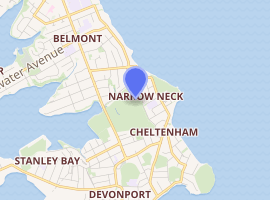Narrow Neck, New Zealand
Until the mid-19th century, Devonport was connected with the rest of the North Shore by a causeway between Ngataringa Bay and the Hauraki Gulf. This causeway gave the appearance of a "narrow neck". On the eastern side of this strip of land is the Narrow Neck beach, on the western side there was an extensive mangrove swamp.
Narrow Neck | |
|---|---|
Suburb | |

| |
| Country | New Zealand |
| Local authority | Auckland Council |
| Electoral ward | North Shore Ward |
| Population (2018) | |
| • Total | 4,098 |
| Belmont | (Hauraki Gulf) | |
| Bayswater |
|
|
| Stanley Bay | Devonport | Cheltenham |
Narrow Neck is a suburb of Auckland, New Zealand.
In the late 19th century the majority of this mangrove swamp was drained and filled in creating land used as a racecourse until the 1930s and subsequently a golf course. In the World Wars the area was used for a military training camp. From 1927 until the mid-1930s a Royal New Zealand Navy ammunition storage facility was located in the suburb; the munitions were moved to the Kauri Point Armament Depot from 1937.
Close to the western edge of the reclaimed area a new road was put through creating a more direct link between Devonport and Takapuna.
Narrow Neck is under the local governance of the Auckland Council.
Demographics
| Year | Pop. | ±% p.a. |
|---|---|---|
| 2006 | 3,852 | — |
| 2013 | 3,984 | +0.48% |
| 2018 | 4,098 | +0.57% |
| Source: [1] | ||

The statistical area of Narrow Neck, which includes Vauxhall, had a population of 4,098 at the 2018 New Zealand census, an increase of 114 people (2.9%) since the 2013 census, and an increase of 246 people (6.4%) since the 2006 census. There were 1,428 households. There were 1,956 males and 2,142 females, giving a sex ratio of 0.91 males per female. The median age was 40.8 years, with 858 people (20.9%) aged under 15 years, 705 (17.2%) aged 15 to 29, 1,935 (47.2%) aged 30 to 64, and 600 (14.6%) aged 65 or older.
Ethnicities were 86.5% European/Pākehā, 6.6% Māori, 1.8% Pacific peoples, 9.9% Asian, and 3.1% other ethnicities (totals add to more than 100% since people could identify with multiple ethnicities).
The proportion of people born overseas was 33.3%, compared with 27.1% nationally.
Although some people objected to giving their religion, 59.8% had no religion, 29.6% were Christian, and 5.1% had other religions.
Of those at least 15 years old, 1,347 (41.6%) people had a bachelor or higher degree, and 249 (7.7%) people had no formal qualifications. The median income was $43,300. The employment status of those at least 15 was that 1,629 (50.3%) people were employed full-time, 558 (17.2%) were part-time, and 75 (2.3%) were unemployed.[1]
References
- "Statistical area 1 dataset for 2018 Census". Statistics New Zealand. March 2020. Narrow Neck (130700). 2018 Census place summary: Narrow Neck
External links
- Soldiers from Narrow Neck marching through Auckland, World War II
- Photographs of Narrow Neck held in Auckland Libraries' heritage collections.